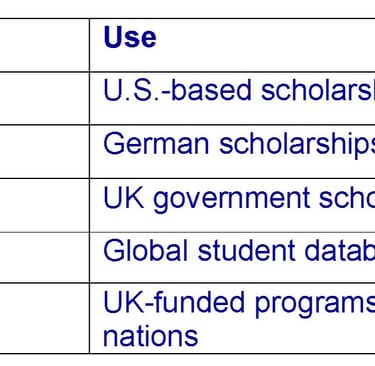✉ shreeconsultancyjsb@gmail.com ✆ Ph. No.: +91 78781-47589 , +91 97828-06464

Step-by-Step Guide to Applying for Scholarships to Study Abroad
Learn how to apply for scholarships to study abroad with this detailed, step-by-step guide. Discover eligibility, documents, tips, and common mistakes to avoid.
Step-by-Step Guide to Applying for Scholarships to Study Abroad
Introduction
Studying abroad is a dream for many students, but the cost often becomes a hurdle. Scholarships to study abroad offer a golden opportunity to fulfill this dream without overwhelming financial stress. In this guide, we’ll walk you through each step to successfully apply for scholarships that can fund your international education journey.
Understanding Study Abroad Scholarships
Types of Scholarships
Merit-Based Scholarships – Based on academic excellence or exceptional talent.
Need-Based Scholarships – Awarded to students from low-income backgrounds.
Subject-Specific Scholarships – Tailored for certain fields like engineering, arts, or medicine.
Destination-Based Scholarships – Offered by governments or institutions in specific countries.
Who Offers Them?
Universities and colleges
Government bodies (e.g., Fulbright, Chevening)
NGOs and private organizations (e.g., DAAD, Rotary Foundation)
Researching the Right Scholarships
Begin with a list of countries you wish to study in. Then look for:
Country-Specific Scholarships (e.g., Commonwealth for UK)
University Scholarships on the school’s financial aid page
External Scholarships via platforms like Scholarships.com or DAAD
Create a spreadsheet to track deadlines, eligibility, and requirements.
Eligibility Criteria
Each scholarship will have specific conditions:
Academic Performance – Minimum GPA or grades
Language Skills – TOEFL, IELTS scores
Community Involvement – Volunteer work or leadership roles
Nationality – Some are region-locked (e.g., only for African or Asian students)
Documents Required
Be ready with:
Academic Records
Valid Passport
Language Proficiency Proof (TOEFL/IELTS)
Letter of Recommendation (LOR)
Statement of Purpose (SOP)
Scholarship Essays
Keep scanned and original copies ready.
Crafting a Winning Statement of Purpose (SOP)
This is your chance to shine personally and professionally.
Include:
Career goals
Why that country/university
How the scholarship will help
Tips:
Be specific
Avoid clichés
Proofread multiple times
Writing Scholarship Essays
Common Prompts:
Tell us about a challenge you overcame.
Why should you be awarded this scholarship?
Best Practices:
Follow word count
Be authentic
Use active voice
Highlight leadership and impact
Gathering Recommendation Letters
Choose mentors, professors, or employers who know you well.
Include:
Relationship to you
Academic/work achievements
Personal qualities relevant to studying abroad
Preparing for Scholarship Interviews
Common Questions:
Why this university/country?
How will you use the scholarship?
Tips:
Dress professionally
Practice with mock interviews
Stay confident and clear
Avoiding Common Mistakes
Missing deadlines
Not tailoring your application
Grammatical errors in essays
Forgetting to follow up
Application Submission Process
Online Portals:
Most scholarships use online systems. Register, fill out the form, upload documents, and submit.
Offline (Postal):
If required, courier the package with all documents in proper order.
Always double-check submission confirmation emails.
After Applying: What Next?
Track application status
Prepare backup options
Wait for interview or result announcements
Once selected, confirm acceptance within the deadline
Scholarships for Undergraduate vs. Postgraduate Students
Undergrad: Often limited to merit or need-based aid
Postgrad: More research-focused and includes assistantships
Financial Planning Beyond the Scholarship
Scholarships may not cover:
Airfare
Accommodation
Daily expenses
Medical insurance
Have an emergency fund or a secondary income source if allowed.
Success Stories & Testimonials
Anita Sharma, a Delhi University student, secured a DAAD scholarship and is now pursuing her master's in Germany.
Ravi Mehta, from Mumbai, earned a full-ride from the Fulbright program and now works at a top US tech firm.
Useful Tools & Platforms
Conclusion
Applying for scholarships to study abroad isn’t just about writing good essays—it’s about planning, research, and presenting your best self. Start early, stay organized, and don’t get discouraged by rejections. With persistence, your scholarship dream can become a reality!
FAQs About Scholarships to Study Abroad
Q1: When should I start applying for scholarships?
A: Start at least 6-12 months before your intended intake.
Q2: Can I apply for multiple scholarships?
A: Yes, but check if they allow combining with other funding.
Q3: What GPA is required for scholarships?
A: Most merit scholarships expect 3.0 GPA or above, but criteria vary.
Q4: Do I need work experience?
A: Mostly for postgraduate programs or leadership-based scholarships.
Q5: Are there scholarships without IELTS/TOEFL?
A: Yes, especially for programs taught in other languages or if you’re from an English-speaking country.
Q6: Can I get a scholarship after joining the course?
A: Some institutions offer in-course scholarships, but it's less common.


